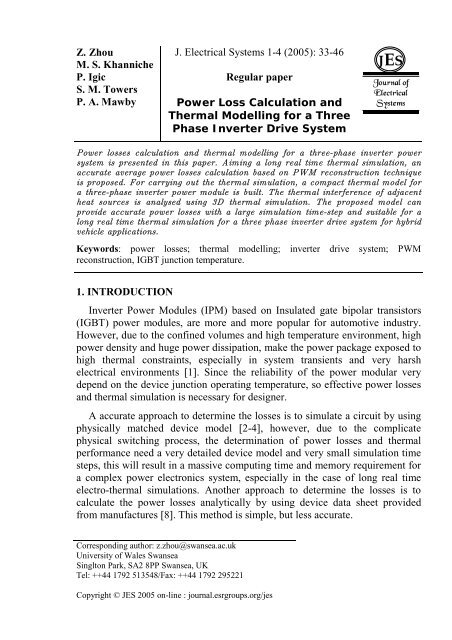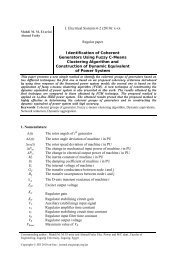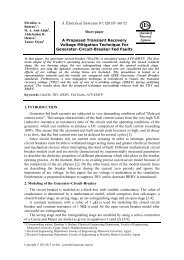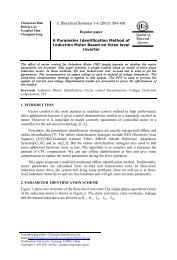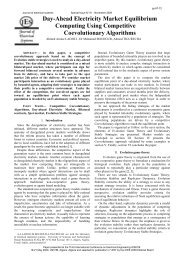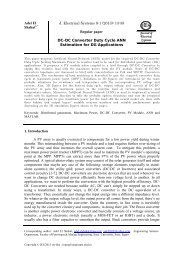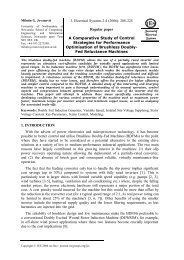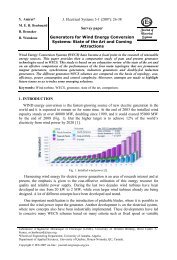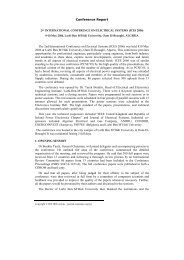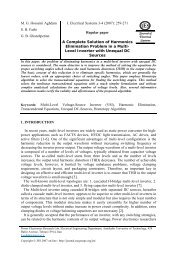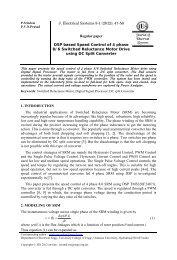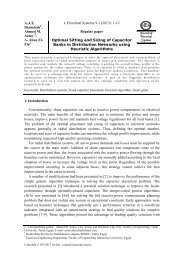Power Loss Calculation and Thermal Modelling for a Three Phase ...
Power Loss Calculation and Thermal Modelling for a Three Phase ...
Power Loss Calculation and Thermal Modelling for a Three Phase ...
Create successful ePaper yourself
Turn your PDF publications into a flip-book with our unique Google optimized e-Paper software.
Z. Zhou et al: <strong>Loss</strong> <strong>Calculation</strong> <strong>and</strong> <strong>Thermal</strong> <strong>Modelling</strong> <strong>for</strong> 3 <strong>Phase</strong> Inverter...E ( k) = f ( i ( k), T ( k))(4)sw −on sw −on c jE ( k) = f ( i ( k), T ( k))(5)sw −off sw −off c jThe total switching loss is calculated byE ( k) = E ( k) + E ( k)(6)sw sw −on sw −off<strong>and</strong> represented asEsw( k )= fsw ( ic ( k), Tj( k))(7)where, k denotes the k th PWM switching pluse. The measured total IGBTswitching energy losses against collect current <strong>and</strong> junction temperature isshown in Figure 2. It can be seen that the total switching energy loss increaseswith increase of collect current <strong>and</strong> junction temperature, <strong>and</strong> can be consideredas a function of the collect current <strong>and</strong> junction temperature The averageswitching power loss of a switching cycle is then calculated by1P ( k) = E ( k)(8)sw _ ave swTswIf the dc link voltage is changed, the the switching losse characteristics willvary to reflect this change. Adding Eq. (3) <strong>and</strong> (8), the average power lossP over each switching cycle is calculated byave _ lossP ( k) = P ( k) + P ( k)(9)ave _ loss sw _ ave cond _ ave3. PWM AND DEVICE CURRENT RECONSTRUCTION FOR POWERLOSSES CALCULATIONThe simulation in Figure 3 gives the effective motor voltages <strong>and</strong> currents,which are continuous quantities (rather than the actual PWM switchingwave<strong>for</strong>ms) <strong>and</strong> cannot directly be used <strong>for</strong> power losses calculation.There<strong>for</strong>e, a PWM reconstruction technique is proposed <strong>for</strong> the power lossessimulation. By using PWM reconstruction technique, device current <strong>and</strong> the ontimeof device can be mathematically reconstructed <strong>for</strong> power lossescalculation. Figure 3 shows the block diagram of the PWM <strong>and</strong> device currentreconstruction.where,mV <strong>and</strong>mI are the effective motor terminal voltage <strong>and</strong> current vectors.The mathematical method to reconstruct the PWM signals will depend on theactual PWM strategy applied. Figure 4 shows a three-phase PWM invertercircuit.36
Z. Zhou et al: <strong>Loss</strong> <strong>Calculation</strong> <strong>and</strong> <strong>Thermal</strong> <strong>Modelling</strong> <strong>for</strong> 3 <strong>Phase</strong> Inverter...to describe the heat-source terms <strong>for</strong> a thermal solver, this allows electrothermalper<strong>for</strong>mance of the inverter to be predicted over long periods of realtime. This simulation methodology brings together accurate models of theelectrical systems per<strong>for</strong>mance, state of the art-device compact models <strong>and</strong> arealistic simulation of the thermal per<strong>for</strong>mance in a useable period of CPUtime.10050Torque (Nm)0-50-1000 100 200 300 400 500 60040003000Speed (rpm)2000100000 100 200 300 400 500 600Time (second)Figure 16: Motor torque (Nm) <strong>and</strong> speed (rpm).300Motor phase currents (A)2001000-100-200-3000 100 200 300 400 500 600150Motor phase voltages (V)100500-50-100-1500 100 200 300 400 500 600Time (second)Figure 17: Motor stator three phase currents <strong>and</strong> voltages.44
J. Electrical Systems 1-4 (2005): 33-46Figure 18: power losses of IGBT (W).Figure 19: Junction temperature of IGBT ( o C).45
Z. Zhou et al: <strong>Loss</strong> <strong>Calculation</strong> <strong>and</strong> <strong>Thermal</strong> <strong>Modelling</strong> <strong>for</strong> 3 <strong>Phase</strong> Inverter...AcknowledgmentThe authors would like to thank Toyota Motor Corporation <strong>for</strong> their financialsupport <strong>and</strong> technical advice.REFERENCES[1] M. Ishiko, M. Usui, T. Ohuchi <strong>and</strong> M. Shirai, Design Concept <strong>for</strong> Wire- BondingReliability Improvement by Optimizing Position in <strong>Power</strong> Devices, ISPS’04 7 thInternational Conference on <strong>Power</strong> Semiconductors, Prague, 31 August – 3September 2004, pp 39 44, 2004.[2] T. Kojima, Y. Yamada, M. Ciappa, M. Chiavarini <strong>and</strong> W. Fichtner, A NovelElectro-thermal Simulation Approach of <strong>Power</strong> IGBT modules <strong>for</strong> automotivetraction applications, Proceeding of 2004 international symposium on powersemiconductor devices & ICs, Kitakyushu, 2004.[3] H. A. Mantooth <strong>and</strong> A. R. Hefner, Electrothermal Simulation of an IGBT PWMinverter, IEEE Transaction on <strong>Power</strong> Electronics, vol. 12, no.3, May 1997.[4] R. Hefner <strong>and</strong> D. L. Blackburn, <strong>Thermal</strong> component models <strong>for</strong> electro-thermalnetwork simulation, IEEE Transactions on Components Package. Manufacture.Technology, vol. 17, p. 413, 1994.[5] A. D. Rajapakse, A. M. Gole, <strong>and</strong> P. L. Wilson, Electromagnetic TransientSimulation Models <strong>for</strong> Accurate Representation of Switching <strong>Loss</strong>es <strong>and</strong> <strong>Thermal</strong>Per<strong>for</strong>mance in <strong>Power</strong> Electronic Systems, IEEE Transactions on <strong>Power</strong>Delivery, vol.20, no.1, pp 319-327, 2005.[6] D. Xu, H. Lu, L. Hang, S. Azuma, M. Kimata <strong>and</strong> R. Uchida, <strong>Power</strong> <strong>Loss</strong> <strong>and</strong>Junction Temperature Analysis of <strong>Power</strong> Semiconductor Devices, IEEETransaction on Industry Applications, Vol..38, No.5, pp, 1426-1431,September/October 2002.[7] Introduction to the 600V ADD-A-pak TM <strong>and</strong> INT-A-pak TM IGBT Modules,International Rectifier Application notes 1992.[8] A. Laprade <strong>and</strong> R. H. R<strong>and</strong>al, Numerical Method <strong>for</strong> Evaluating IGBT <strong>Loss</strong>es,Application Note 7520 Rev. A1.[9] Analog Devices: ADMC401 Double Update Mode of PWM generation Unit,Analog Devices, Inc., 1999.[10] Semikron application notes on heat sink systems.46


